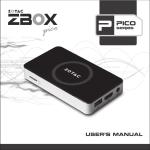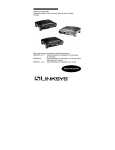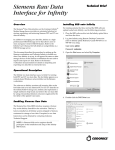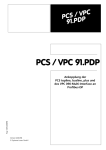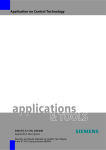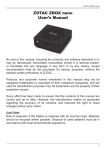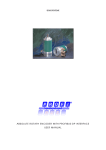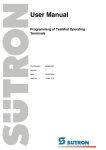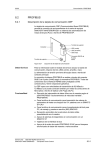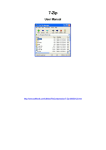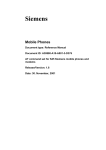Download User Manual - Sütron electronic GmbH
Transcript
User Manual Connection to PROFIBUS-DP Part Number: 80 860.655 Version: 2 Date: 22.11.2005 Valid for: TSwin .net 4.0x TSwin .net 4.1x Version 1 2 Date 25.07.2005 22.11.2005 Modifications First edition Validation extended, chapter "Important Notes" added This manual, including all illustrations contained herein, is copyright protected. Use of this manual by any third party in departure from the copyright provision is forbidden. No part of this manual may be reproduced, translated or electronically or photographically archived or altered without the express written consent from Sütron electronic GmbH. Violations shall be cause for damage liability. Sütron electronic reserves the right to make any changes that contribute to technical improvement. Overall Table of Contents Overall Table of Contents 1 2 Important Notes ....................................................................................................... 1-1 1.1 Symbols .................................................................................................... 1-1 1.2 Safety Notes ............................................................................................. 1-1 1.3 Intended Use............................................................................................. 1-1 1.4 Target Group............................................................................................. 1-2 PROFIBUS-DP ........................................................................................................ 2-1 2.1 2.1.1 2.2 Specification for PROFIBUS-DP............................................................... 2-1 Diagnosis ............................................................................................. 2-1 Data Profile ............................................................................................... 2-2 2.2.1 Request telegram ................................................................................ 2-2 2.2.2 Response Telegram ............................................................................ 2-3 2.2.3 User Data............................................................................................. 2-3 2.2.4 Reading and Writing Bytes .................................................................. 2-4 2.2.5 Reading Bits ........................................................................................ 2-4 2.2.6 Writing Bits........................................................................................... 2-4 2.3 Programming ............................................................................................ 2-4 2.3.1 Protocol Parameters ............................................................................ 2-4 2.3.1.1 Maximum Waiting Time For Response.......................................................................2-5 2.3.1.2 Delay until Connection Set-Up....................................................................................2-5 2.3.1.3 Station Number...........................................................................................................2-5 2.3.1.4 Telegram Length.........................................................................................................2-5 2.3.1.5 Floating Point Numbers in the Siemens Format .........................................................2-5 2.3.1.6 Timer and Counter in the Siemens Format.................................................................2-6 2.3.1.7 Byte Order ..................................................................................................................2-6 2.3.1.8 Address Width ............................................................................................................2-6 2.3.2 Polling Area ......................................................................................... 2-6 2.3.3 Input Syntax ......................................................................................... 2-7 2.4 Physical Connection ................................................................................. 2-8 2.4.1 Pin Assignment .................................................................................... 2-8 2.4.2 Cable for PROFIBUS-DP..................................................................... 2-8 2.4.3 Transfer Speed and Line Length ......................................................... 2-9 2.5 Error Messages....................................................................................... 2-10 2.6 Applications............................................................................................. 2-12 2.6.1 Siemens S7 Controllers ..................................................................... 2-12 2.6.1.1 Hardware Configurator .............................................................................................2-12 2.6.1.2 PROFIBUS Function Blocks .....................................................................................2-15 2.6.1.3 Importing the STL Source Files ................................................................................2-15 2.6.1.4 General Functioning .................................................................................................2-16 2.6.1.5 SFC14 Functioning ...................................................................................................2-17 2.6.1.6 FC80 Functioning .....................................................................................................2-18 2.6.1.7 SFC15 Functioning ...................................................................................................2-18 2.6.1.8 Example for an OB1 .................................................................................................2-18 i Overall Table of Contents A ii 2.6.1.9 Defining Variables .................................................................................................... 2-19 2.6.2 Siemens S5 Controllers ..................................................................... 2-19 2.6.2.1 Parameter Settings for IM308B ................................................................................ 2-19 2.6.2.2 Data Consistency ..................................................................................................... 2-20 2.6.2.3 PLC Program............................................................................................................ 2-20 2.6.2.4 FB110 Evaluation Block ........................................................................................... 2-21 2.6.2.5 FB111 - Reading from the Data Block...................................................................... 2-22 2.6.2.6 FB112 - Writing to the Data Block ............................................................................ 2-22 2.6.2.7 Protocol Parameters for the Siemens S5 Series ...................................................... 2-23 2.6.2.8 Defining Variables .................................................................................................... 2-23 2.6.3 Rexroth Controllers ............................................................................ 2-24 2.6.3.1 Configuration in WINSPS ......................................................................................... 2-24 2.6.3.2 Configuration in PROFI ............................................................................................ 2-26 2.6.3.3 Protocol Parameters for BM DP12 ........................................................................... 2-28 2.6.3.4 Protocol Parameters for the Bosch CL Series.......................................................... 2-29 2.6.3.5 Defining Variables .................................................................................................... 2-29 Index ....................................................................................................................... A-1 Important Notes 1 Important Notes 1.1 Symbols The symbols in this manual are used to draw your attention on notes and dangers. Danger This symbol is used to refer to instructions wich, if ignored or not carfully followed could result in personal injury. Note This symbol indicates application tips or supplementary notes. Reference to source of information This symbol refers to detailed sources of information on the current topic. 1.2 Safety Notes – Read this manual carefully before using the operating device. Keep this manual in a place where it is always accessible to all users. – Proper transportation, handling and storage, placement and installation of this product are prerequisites for its subsequent flawless and safe operation. – This user manual contains the most important information for the safe operation of the device. – The user manual, in particular the safety notes, must be observed by all personnel working with the device. – Observe the accident prevention rules and regulations that apply to the operating site. – Installation and operation must only be carried out by qualified and trained personnel. 1.3 Intended Use – The device is designed for use in the industry. – The device is state-of-the art and has been built to the latest standard safety requirements. However, dangerous situations or damage to the machine itself or other property can arise from the use of this device. – The device fulfills the requirements of the EMC directives and harmonized European standards. Any modifications to the system can influence the EMC behavior. 1-1 Important Notes 1.4 Target Group All configuration and programming work in connection with the automation system must be performed by trained personnel only (e.g. qualified electricians, electrical engineers). The configuration and programming personnel must be familiar with the safety concepts of automation technology. 1-2 PROFIBUS-DP 2 PROFIBUS-DP Profibus DP provides a manufacturer- and controller-independent data transmission protocol. The Profibus DP is a speed-optimized Profibus variant that is specially tailored to communication between programmable controllers and decentralized peripheral devices. Profibus DP is implemented in the operating device and meets the requirements of parts 1 and 3 of the German standard DIN 19245. It also corresponds to the European field bus standard EN 50170. As the operating device fulfills standardization requirements, it can be successfully integrated as a slave into the Profibus DP. All operating devices can be linked using an integrated Profibus DP additional module. You can also link several operating devices to one master controller. The entire PROFIBUS DP protocol is handled by the protocol chip SPC3. Transfer speeds of up to 12 MBaud are possible. The operating device is used in the bus as a decentralized module that occupies up to 256 inputs and outputs. The size can be programmed from between 8- and 32byte IN data, and between 8- and 32-byte OUT data. Data transfer is carried out via the peripheral area. The input/output image is exchanged cyclically between the master and operating device via the bus. In this context, the operating device uses the cyclical input/output image for data exchange between the master and the slave. The data content to be interpreted is defined for both partners in a data profile. All services required for running the operating device originate in the operating device. The operating device has client functions. The controller reacts to the requests of the operating device. It has server functions. The master module must interpret the incoming data according to the profile and also respond according to the profile. This is carried out using a function block in the controller that is able to interpret the requests in the IN data, and write a response to the OUT data. 2.1 Specification for PROFIBUS-DP The specification of the operating device in PROFIBUS DP is defined using the device data base (GSD) file SE03081A.GSD. 2.1.1 Diagnosis The operating device implements the station-related diagnosis. 5-byte user diagnosis data is transferred – 1st byte = error number (1 = communication error in the operating device) – 2nd and 3rd byte communication error code – 4th and 5th byte communication error subcode The communication-error code and subcode are the values that are also displayed on the operating device. 2-1 PROFIBUS-DP 2.2 Data Profile To allow direct data access to the different data areas in a controller, a data profile must be agreed between the master and the slave. The first four bytes of the telegram length set are used as follows: – Telegram sequential number and length – Definition of the access – Definition of the data area 2.2.1 Table 2-1 Request telegram Request telegram Byte Content 1 Number of user data, sequential number of telegram 2 Access 3 Offset (Depends on Byte Order Setting) 4 High (Low) 5 User Data 1st Byte 6 User Data 2nd Byte n User Data nth Byte Low (High) Byte 1: Number of User Data Table 2-2 Number of User Data Bit Content 0 Number of User Data in Bytes. Specifies the number of bytes for the user data transfer. 1 2 3 4 5 6 7 2-2 Sequential Number of the Telegram. Identification number for each communication process. (0 = initialization cycle, 1 - 7 = normal sequential number) PROFIBUS-DP Byte 2: Access Table 2-3 Access Bit Content 0 Byte Number For Word Access 0 = First Byte, 1 = Second Byte 1 Reserved 2 3 4 5 6 7 Access: 00 = Bit 01 = Byte 02 = Word 03 = Double word Data Direction: 0 = Read 1 = Write Byte 3 and 4: Offset These bytes contain the address for accessing a data area. Byte 5 ff: User Data The user data are located from byte 5 onwards to the end of the telegram. 2.2.2 Table 2-4 Response Telegram Response telegram Byte Content 1 Number of User Data 2 Access 3 Return Code 4 0x00 5 User Data 1st Byte 6 User Data 2nd Byte n User Data nth Byte 2.2.3 Error User Data The user data are located from byte 5 onwards to end of the telegram. 2-3 PROFIBUS-DP 2.2.4 Reading and Writing Bytes Depending on the telegram length and access, up to 28 bytes of user data can be transferred during reading and writing operations. When bytes are being read and written, the user data appears in the telegram as of byte five. 2.2.5 Reading Bits When the system reads bits, it reads a byte, word or double word, based on the address width of the data area to be read. The operating device masks out the requested bits, and displays the data in line with the display settings. 2.2.6 Writing Bits Only an individual bit is set or deleted. The controller receives a bit mask and link information from the operating device via the request telegram. The bit is set or deleted in the target address using the bit mask and the link information. The byte order of the bit mask for word addresses is oriented to the protocol parameters specified for the byte order. Table 2-5 Writing to a byte address Byte Content 5 Bit Mask 6 Logical Operation 0 = AND 1 = OR Table 2-6 Writing to a word address Byte Content 5 Bit Mask LOW 6 Bit Mask HIGH 7 Logical Operation 0 = AND 1 = OR 2.3 Programming 2.3.1 Protocol Parameters With the protocol parameters, you can adapt the communication of the controller used. 2-4 PROFIBUS-DP 2.3.1.1 Maximum Waiting Time For Response This parameter specifies how long the operating device waits for a response from the controller. Table 2-7 Maximum waiting time for response Configurable Values Default Value 1 ms to 65535 ms 1000 ms 2.3.1.2 Delay until Connection Set-Up This parameter specifies the waiting time after which the operating device starts the communication. Table 2-8 Delay until connection set-up Configurable Values Default Value 1000 ms to 65535 ms 5000 ms 2.3.1.3 Station Number Specifies the station number of the operating device within the PROFIBUS-DP structure. The station numbers 0 to 2 are reserved. Table 2-9 Station number Configurable Values Default Value 3 to 124 3 2.3.1.4 Telegram Length The telegram length is set to the PROFIBUS configuration. Specigy the same value in the PROFIBUS programming software. Table 2-10 Telegram length Configurable Values Default Value 8 Byte to 32 Byte 20 Byte 2.3.1.5 Floating Point Numbers in the Siemens Format This parameter specifies whether floating point numbers are exchanged in the Siemens-specific format or IEEE format. Table 2-11 Floating point numbers in the Siemens format Configurable Values Default Value OFF X ON 2-5 PROFIBUS-DP 2.3.1.6 Timer and Counter in the Siemens Format This parameter specifies wether timer and counter are exchanged in the Siemensspecific format or IEEE format. Table 2-12 Timer and counter in the Siemens format Configurable Values Default Value OFF X ON 2.3.1.7 Byte Order Specify the byte order for word and double-word addresses. (Siemens = High-Low, Bosch = Low-High) Table 2-13 Byte order Configurable Values Default Value Low-High X High-Low 2.3.1.8 Address Width Specify the address width you want the operating device to use when accessing controller addresses. Table 2-14 Adress width Configurable Values Default Value 1 = Byte Address 2 = Word Address X 4 = Doppel-Word Address 2.3.2 Polling Area Limits applying to the poll area: 2-6 – The variable must be word-oriented. – The area must be contiguous. – The controller must be able to access this area in bit-mode. – The operating device must be able to access this area in word-mode. PROFIBUS-DP 2.3.3 Input Syntax The following figure illustrates the structure of the input syntax for variables in the programming software. B S7 Number DB Number B DB Number DBX Figure 2-1 . Number Syntax diagram for bit access, PROFIBUS-DP. (1) BY S7 Number DB Number BY DB Number DBB Figure 2-2 . Number (2) Number Syntax diagram for byte access, PROFIBUS-DP. 1 The number in front of the point is a word or double-word address. The number after the point specifies the byte number within the word/double word. 2 The number in front of the point is a byte address. W S7 Figure 2-3 Number DB Number W DB Number DBW Syntax diagram for word access, PROFIBUS-DP. DW S7 Figure 2-4 Number DB Number DW DB Number DBD Syntax diagram for double-word access, PROFIBUS-DP 2-7 PROFIBUS-DP 2.4 Physical Connection 2.4.1 Pin Assignment Figure 2-5 9 pin D-SUB female connector strip Connector in the terminal: 9 pin D-SUB female connector strip. Table 2-15 Pin assignment PROFIBUS DP Pin Designation Function 1 nc Not Connected 2 nc Not Connected 3 RxD/TxD-P Received Data / Transmitted Data Plus 4 CNTR-P Repeater Control Signal Plus 5 DGND Data Transmission Potential 6 VP Supply Voltage of Terminators Plus 7 nc Not Connected 8 RxD/TxD-N Received Data / Transmitted Data Minus 9 CNTR-N Repeater Control Signal Minus 2.4.2 Cable for PROFIBUS-DP In the wiring depicted below, the potential difference between the data reference potentials DGND of all connections are NOT to exceed +/- 7 V. Ensure that no compensating current flow through the bus cable shield. Install a separate equipotential bonding conductor. RxD/TxD-P RxD/TxD-N 3 WH WH 3 8 BN BN 8 Figure 2-6 2-8 Connecting cable PROFIBUS-DP RxD/TxD-P RxD/TxD-N PROFIBUS-DP There are two cable specifications for PROFIBUS-FMS and PROFIBUS-DP: Table 2-16 Cable specification for PROFIBUS Parameter Cable type A Cable type B Wave Impedance 135 to 165 Ohm (for f = 3 to 20 MHz) 100 to 135 Ohm (for f > 100 MHz Cable capacity < 30 pF/m < 60 pF/m Wire cross-section > 0.34 mm2 > 0.22 mm2 Loop Impedance < 110 Ohm/km --- Signal attentuation max. 9 dB max. 9 dB Cable type twisted-pair 1 x 2 / 2 x 2 / 1 x 4 wires twisted-pair1x 2 / 2 x 2 / 1 x 4 wires Shielding Copper braided shielding or braided shielding + foil shielding Copper braided shielding or braided shielding + foil shielding Cable recommendations: Table 2-17 Cable recommendations for PROFIBUS Field of Application Manufacturer Order Number Standard Siemens 6XV1 830-0AH10 Trailing cable Siemens 6XV1 830-3BH10 Connector recommendations: Table 2-18 Connector recommendations for PROFIBUS Manufacturer Order Number Siemens 6ES79 0BA20-0XA0 2.4.3 Transfer Speed and Line Length With the PROFIBUS, data can be transferred using different transfer speeds. However, the higher the transfer speed, the shorter the maximum permitted line length. The values listed in the following table apply to the cable type A which is more closely specified in DIN E 19245 part 3. Table 2-19 Transfer speed versus line length for PROFIBUS Baud Rate (Bit/s) Line Length (m) 187 500 1000 500 000 400 1 500 000 200 3 000 000 100 6 000 000 100 12 000 000 100 2-9 PROFIBUS-DP 2.5 Error Messages Error messages are displayed on the operating device along with a code and subcode. Error messages are composed as follows: Communication Error Table 2-20 Code Code XXXXX Subcode XXXXX Retries XXXXX Fehlermeldungen PROFIBUS-DP Subcode Error Type 1 Slave is currently not ready 2 Packets out of sequence 3 Protocol framing error 4 Timeout 5 CRC error 6 Parity error 7 Send process aborted 8 Receive process aborted 9 Buffer too small for cyclic data 10 No cyclic data defined 12 Cyclic data already defined 15 The selected protocol is not supported 16 Receive buffer overrun 40 Undefined system variable 1 50 Error initializing the SPC3 1 Buffer too large 2 No initialization of SPC3 4 No memory for telegram buffer 60 No configuration from master 61 Wrong input length 62 Wrong output length 63 Error in configuration data, reparameterization required 64 Protocol chip requires configuration update, reparameterization required. 65 No communication via protocol chip, reparameterization required. 2-10 Possible Cause PROFIBUS-DP Table 2-20 Code Fehlermeldungen PROFIBUS-DP Subcode Error Type 66 Protocol chip reset, reparameterization required. 67 Watchdog time error, reparameterization required. 70 Operating device is not polled 71 0 Distinguishing feature for manufacturer 1 Distinguishing feature for manufacturer xxx No response to order. xxx = variable number 100 Possible Cause Base no. for error from PLC function block. PLC error is added to 100. The subcode indicates the offset value for the access, during which the error occurred. i.e. 102 Access to DB via FB111 / FB112 DB does not exist 2-11 PROFIBUS-DP 2.6 Applications The controller program, which is usually a function block, must handle the requests of the operating device in line with the data profile. The details depend on the controller. The following sections explain the controllerspecific applications that have been developed to date. The device data base (GSD) file SE03081A.GSD can be used to set the parameters of the operating devices in the PLC software. This file is available in a subdirectory of the programming software and in our Internet download area. 2.6.1 Siemens S7 Controllers The following dialog boxes and the way in which they are used may vary in the different versions of Step7 software. The procedure for defining a PROFIBUS DP slave is the same in all versions, but is not described in this documentation. The dialog boxes depicted here were developed for version 5.1 of an S7-300 controller. 2.6.1.1 Hardware Configurator To integrate the operating device into the PROFIBUS DP structure, you must firstly introduce the operating devices into the system. Proceed as follows: 1. Start the Hardware Configurator in S7. 2. From the Options menu, select the menu item Install New GSD. The following dialog opens. Figure 2-7 Dialog 'Install New GSD' 3. From your main TSwin directory navigate to the subdirectory ..\FBs\Profibus\TYP_GSD. 4. Select the file SE03081A.GSD. 5. Click 'Open' to confirm your selection. 2-12 PROFIBUS-DP In the hardware catalog, the operating device is then listed as follows: Figure 2-8 Hardware catalog To integrate the operating device into PROFIBUS-DP, do the following: 1. Click on the TesiMod BT item and, keeping the mouse button pressed, drag and drop this item to the icon for the PROFIBUS DP master system. The pointer becomes a cross. 2. Release the mouse button. The following dialog opens. Figure 2-9 Dialog 'Properties - PROFIBUS interface TesiMod BT 3. Specify an address for the operating device (3). 4. Click OK to confirm your actions. 2-13 PROFIBUS-DP The hardware configurator now looks as shown below: Figure 2-10 Hardware configuration You must also set the parameters for the operating device as a DP slave. Proceed as follows: 1. Click on the element Universal Module and, keeping the mouse button pressed, drag and drop the element to the top line in the table. The pointer becomes a cross. Release the mouse button. The item is entered into the table. 2. Select the menu item Object Properties from the Edit menu. 3. Specify the properties as shown below. 2-14 PROFIBUS-DP Figure 2-11 Dialog Properties - DP Slave You can select your entries for address, length, and unit as needed. The settings depicted below generate the value 191 in the ID byte. 2.6.1.2 PROFIBUS Function Blocks You need Sütron function blocks to interpret and evaluate the data. The cyclical call sequence of the function blocks must be adhered to. 2.6.1.3 Importing the STL Source Files Import the STL (AWL) files supplied with the product in the Simatic Manager. Proceed as follows: 1. Select the Sources folder in the Simatic Manager. 2. From the Insert menu, select the menu item External Source. The following dialog opens. Figure 2-12 Dialog Insert External Source 3. From your main TSwin directory navigate to the subdirectory ..\FBs\PROFIBUS\SIEMENS\S7\300_400. 4. Select the STL file FC70.AWL and select Open to confirm. The name is now entered in the Sources folder in the S7 Manager. 5. Open the STL file, and compile and convert it into the S7 function block format. 2-15 PROFIBUS-DP 2.6.1.4 General Functioning The peripheral data is processed using the functions SFC14 and SFC15 of the S7 CPU. SFC14 reads the peripheral data, and SFC15 writes the data to the periphery. FC80 takes on the data provided by SFC14 and calls the read or write function, and transfers the data read to SFC15. The local data stack of FC80, FC81, and FC82 is used to process protocol data. SFC14, FC70 (FC80) and SFC15 must be called cyclically in the program. The following cyclical call sequence must be adhered to: 1 SFC14 2 FC70 (FC80) 3 SFC15 The functions FC80, FC81, and FC82 use the register-indirect, cross-area address form. If interrupt-controlled program calls are permitted in the program cycle, the contents of the address registers 1 and 2, and possibly also the local data stack, may need to be saved, in addition to the contents of both accumulators. The operating device can access the controller data on a bit, byte, word, or doubleword basis. Bit access is possible to a byte address. As the protocol profile itself does not transfer data type code, these are transferred using the variable numbers. Each variable is uniquely identified using a variable number. This number is defined during programming. 2-16 PROFIBUS-DP The following graphic shows how the function blocks work. Peripherie-Eingänge DB80 W#16#50 P#DB80.DBX 4.0 BYTE 16 PEB80 SFC14 [LADDR] [RECORD_IN] Peripherie-Ausgänge DB81 FC80 [RECORD_OUT] P#DB81.DBX 32.0 BYTE 16 SFC15 W#16#50 PAB80 [LADDR] Figure 2-13 2.6.1.5 How the function blocks work SFC14 Functioning SFC14 reads the data from the peripheral inputs, starting with the start address (LADDR) and copies the data to a specific target (RECORD). The amount of data to be copied is contained in the RECORD parameter. Table 2-21 SFC14 parameters Name Meaning LADDR Specifies the start address for the peripheral inputs of the operating device (hexadecimal) RET_VAL Return value of the SFC14 in case of an error RECORD Copy target for the read peripheral data 2-17 PROFIBUS-DP 2.6.1.6 FC80 Functioning FC80 reads the data transferred from the operating device from the copy target RECORD of SFC14. Based on the telegram transferred, it carries out a read or write access. It then transfers the data to be transferred to the operating device to the source data area of SFC15. Table 2-22 FC80 parameters Name Meaning Record_In Start address for the input data (= parameter RECORD of the SFC14) Record_Out Start address for the output data (= parameter RECORD of the SFC15) 2.6.1.7 SFC15 Functioning SFC15 reads the data from the source RECORD and copies the data to the peripheral outputs, starting with the address LADDR. The amount of data to be copied is contained in the RECORD parameter. Table 2-23 SFC15 parameters Name Meaning LADDR Specifies the start address for the peripheral outputs of the operating device (hexadecimal) RET_VAL Return value of the SFC15 in case of an error RECORD Copy source for the data to be transferred 2.6.1.8 Example for an OB1 The following example refers to the connection of one operating device to the PROFIBUS-DP. ... // Call SFC [LADDR] := [RET_VAL] := [RECORD] := // Call FC [RECORD_IN] := [RECORD_OUT] := // Call SFC [LADDR] := [RECORD] := [RET_VAL] := ... BE 2-18 14 W#16#50 MW62 P#DB80.DBX 4.0 BYTE 16 80 P#DB80.DBX 4.0 BYTE 16 P#DB81.DBX 32.0 BYTE 16 15 W#16#50 P#DB81.DBX 32.0 BYTE 16 MW64 PROFIBUS-DP 2.6.1.9 Defining Variables Specify the variable addresses in either the hexadecimal notation or using the following syntax formats: DB DBX Number Figure 2-14 2.6.2 DBB Number Zahl Number DBW Number Word access for PROFIBUS using a Siemens S7 DB Figure 2-17 Number Zahl Byte access for PROFIBUS using a Siemens S7 DB Figure 2-16 Number Bit access for PROFIBUS using a Siemens S7 DB Figure 2-15 . Number Number DBD Number Double-word access for PROFIBUS using a Siemens S7 Siemens S5 Controllers The PLC program communicates with the PROFIBUS DP via the input/output peripheral area. A separate IN/OUT data channel is assigned to each participant on the PROFIBUS DP (each connected operating device). The assignment is made via the parameterization of the PROFIBUS-DP master module in the Siemens PLC. Controllers in the S5 series usually use the module IM308B or IM308C. 2.6.2.1 Parameter Settings for IM308B A device type file for the COMET200 programming software is available to parameterize the IM308B.(BT081ATD.200) The 'Configuration' option is used to configure the terminal of the DP slave. 2-19 PROFIBUS-DP The following parameters are specified: 1. Position of the operating device in the peripheral area, i.e. the I/O addresses on which the operating device is located. 2. The DP identifier via module 0 Table 2-24 The DP identifier via module 0 Item Value I/O X Length 4, 6, 8, 14, 16 Format Word Consistency 0 Word Consistency 3. Data for the parameterization telegram are not applicable, no entry. Using a program module, this module configuration is loaded into the module with the parameter settings of the entire master module. 2.6.2.2 Data Consistency A data consistency over the entire length set must be applied for exchanging data between the operating device and the master module. However, the master modules IM308B and IM308C only ensure a consistency with a data width of up to one word. Program-specific measures in the PROFIBUS DP driver of TesiMod operating devices ensure consistency up to the maximum data length which can be specified, that is 32 bytes. 2.6.2.3 PLC Program Evaluation of the Control Bytes: The PLC program must cyclically poll the peripheral area that is assigned to the operating device. Using the sequential number, it must check whether a new request has been received from the operating device. FB110 carries out this task. FB110 is parameterized with the peripheral address of the corresponding operating device, to ensure that only one function block is required to connect several operating devices. FB110 must also copy bytes 1 and 2, unchanged, from the request to the response telegram, and 0x00 must be written to byte 3. Take note of the consistency settings when reading and writing to the peripheral area. (Also see the COMET200 manual.) Processing user data: Separate read and write function blocks that are called by FB110 are used to process user data. The read and write function blocks process the user data in line with the data profile. Error Handling: Errors can be entered in the return code, byte 4 of the response telegram. If no error occurs, byte 4 must be deleted. 2-20 PROFIBUS-DP One possible error is: DB does not exist. 2.6.2.4 FB110 Evaluation Block The description for this function block is for version 2.0 and higher (PROF02ST.S5D). The function block (FB) uses MW246 - MW254 as scratch flag. The function block also needs a separate data word for each operating device. The data word is transferred as a parameter during the call. The telegram sequential number is saved in this data word. FB110 cyclically checks the contents of byte 1 - bits 5 to 7. If the value 0 is contained here, the telegram number memory is reset. If in byte 1, bits 5 to 7 are not equal to the content of the telegram number memory, a new request telegram has been received from the operating device, and this must be evaluated and a response sent. FB110 is called cyclically in OB1 with the corresponding parameters for each operating device. Terminal 1 Terminal 2 PW128 PW136 Byte 1 bis 4 P-Bereich Eingänge MB250 MB251 MB252 MB253 0x00 MB250 MB251 MB252 Byte 1 bis 4 PW128 Figure 2-18 Schmiermerker FB110 MB253 Schmiermerker P-Bereich Ausgänge PW136 Structure of FB110 2-21 PROFIBUS-DP 2.6.2.5 FB111 - Reading from the Data Block The description for this function block is for version 2.0 and higher (PROF02ST.S5D). The function block interprets the following bytes in the telegram as follows: – Byte 2, bit 0 is interpreted as a byte code for a byte access to a word address. Table 2-25 FB111 - Byte code in byte 2 Value Meaning 0 DL - High Byte 1 DR - Low Byte – Byte 3 contains the data block number. – Byte 4 contains the data word number within the DB. Siehe Kapitel „Data Profile“ auf Seite 2-2. 2.6.2.6 FB112 - Writing to the Data Block The description for this function block is for version 2.0 and higher (PROF02ST.S5D). The function block interprets the following bytes in the telegram as follows: – Byte 2, bit 0 is interpreted as a byte code for a byte access to a word address. Table 2-26 – FB111 - Byte code in byte 2 Value Meaning 0 DL - High Byte 1 DR - Low Byte Byte 3 contains the data block number. – Byte 4 contains the data word number within the DB. – Byte 5 and – Byte 6 contain the bit mask for the logical operation. – Byte 7 contains the logical instruction (AND / OR). Siehe Kapitel „Data Profile“ auf Seite 2-2. 2-22 PROFIBUS-DP 2.6.2.7 Protocol Parameters for the Siemens S5 Series For the protocol, specify the parameters shown in the figure below. Figure 2-19 2.6.2.8 Protocol parameters for PROFIBUS using a Siemens S5 Defining Variables Specify the variable addresses in either the hexadecimal notation or using the following syntax formats: B DB . Number Number B Number Figure 2-20 Bit access for PROFIBUS using a Siemens S5 (1) BY DB . Number (2) BY Number Figure 2-21 Byte access for PROFIBUS using a Siemens S5 W Number DB Figure 2-22 Number W Word access for PROFIBUS using a Siemens S5 DW DB Figure 2-23 Number Number Number DW Double-word access for PROFIBUS using a Siemens S5 2-23 PROFIBUS-DP 2.6.3 Rexroth Controllers The PLC program communicates with the PROFIBUS DP via the input/output peripheral area. Each participant, including each operating device in the PROFIBUS DP, is assigned an IN and OUT data channel. The channel is assigned using the parameterization of the Bosch controller’s PROFIBUS DP master module. The module MP-DP12 is used in Bosch controllers. 2.6.3.1 Configuration in WINSPS Evaluation of the control bytes in the PLC Program: The PLC program must cyclically poll the peripheral area that is assigned to the operating device. Using the sequential number, it must check whether a new request has been received from the operating device. In addition, bytes 1 and 2 must be copied, unchanged, from the request telegram to the response telegram, and 0x00 must be written to byte 3. You require the following modules for this task. They are contained in a subfolder of the programming software’s installation folder. Table 2-27 Function blocks for the programming software WINSPS Controller Function Block CL200 ..\FBs\Profibus\BOSCH\WINSPS\CL200\BT_PB2.pxl CL300 ..\FBs\Profibus\BOSCH\WINSPS\CL345\BT_PB345.pxl CL400 ..\FBs\Profibus\BOSCH\WINSPS\CL345\BT_PB345.pxl CL500 ..\FBs\Profibus\BOSCH\WINSPS\CL345\BT_PB345.pxl SoftSPS ..\FBs\Profibus\BOSCH\WINSPS\PLC\BT_PBPLC.pxl Error Handling in the PLC Program: Errors can be entered in the return code, byte 4 of the response telegram. If no error occurs, byte 4 must be deleted. Possible errors are: – DB does not exist. Function Blocks Supplied: You must configure the operating device as the slave using 'n Byte kons. Daten E/A' (n byte cons. data I/O) in the DP master module. If you are using interrupts, you must save the scratch flags and the four registers used in the interrupt OB. Inserting the Library Files in WINSPS 1. Start WinSPS. 2. Copy the corresponding pxl file to the ZSO directory of the PLC project. You can only copy the file to the appropriate project directory as modules of the incorrect controller type are not recognized! 3. Assign the library in the toolbar. Example: FC10, R BT_PB345 4. Open the editor in the PLC software. 2-24 PROFIBUS-DP Example: OB1 Select the PROFIBUS block from the 'Edit/Parameter list' menu. Parameterizing the call-up function: Example: For two operating devices: ... ;DEF für Gerät 1 DEF DEF DEF DEF DEF ;DEF für Gerät 2 DEF DEF DEF DEF DEF ;Aufruf Gerät 1 BA P0 P1 P2 P3 P4 ;Aufruf Gerät 1 BA P0 P1 P2 P3 P4 ... 10,-EZ_Basisn 10,-AZ_Basisn DB50,-DBNR 0,-WDNR 20,-TLNG 10,-EZ_Basisn2 10,-AZ_Basisn2 DB50,-DBNR2 0,-WDNR2 20,-TLNG2 W W W W W W W W -BT_345,5FC10 -EZ_Basisn -AZ_Basisn -DBNR -WDNR -TLNG -BT_345,5FC10 -EZ_Basisn2 -AZ_Basisn2 -DBNR2 -WDNR2 -TLNG2 Function Block BT_PB345: The function block BT_DP345 is used to decode the transfer protocol of the operating devices. It ensures consistent data transfer. When you program the controller, note that a total of 64 bytes as of the address DB[P2] W[P3] are reserved for processing the protocol. Other program components cannot use this area! The function block BT_PB345 uses the following parameters: Table 2-28 Parameters for function block BT_PB345 Parameter Function P0 EZ Base Address P1 AZ Base Address P2 Data block for storing the EZ/AZ data P3 Base Address in Data Block [P2] P4 Telegram Length corresponds to the number of EZ/AZ data of the slave configuration (8, 12, 16, 20, 28, or 32 bytes) 2-25 PROFIBUS-DP 2.6.3.2 Configuration in PROFI Table 2-29 Function blocks for the programming software PROFI Controller Function Block CL200 ..\FBs\Profibus\BOSCH\PROFI\CL200\BT_MAIN.PBO ..\FBs\Profibus\BOSCH\PROFI\CL200\BT_READ.PBO ..\FBs\Profibus\BOSCH\PROFI\CL200\BT_WRITE.PBO ..\FBs\Profibus\BOSCH\PROFI\CL200\OB1.PBO CL300 ..\FBs\Profibus\BOSCH\PROFI\CL350400/BT_MAIN.PCO ..\FBs\Profibus\BOSCH\PROFI\CL350400\BT_READ.PCO ..\FBs\Profibus\BOSCH\PROFI\CL350400\BT_WRITE.PCO ..\FBs\Profibus\BOSCH\PROFI\CL350400\OB1.PCO CL400 ..\FBs\Profibus\BOSCH\PROFI\CL350400/BT_MAIN.PCO ..\FBs\Profibus\BOSCH\PROFI\CL350400\BT_READ.PCO ..\FBs\Profibus\BOSCH\PROFI\CL350400\BT_WRITE.PCO ..\FBs\Profibus\BOSCH\PROFI\CL350400\OB1.PCO CL500 ..\FBs\Profibus\BOSCH\PROFI\CL500/BT_MAIN.P5O ..\FBs\Profibus\BOSCH\PROFI\CL350400\BT_READ.P5O ..\FBs\Profibus\BOSCH\PROFI\CL350400\BT_WRITE.P5O ..\FBs\Profibus\BOSCH\PROFI\CL350400\OB1.P5O Function Block BT_MAIN Structure of the block: Terminal 1 Terminal 2 EZ10 EZ20 Byte 1 to 4 MB250 EZ-Area Inputs MB251 MB252 MB253 0x00 MB250 MB251 MB252 Byte 1 to 4 2-26 Scatch Flags BT_MAIN MB253 Scatch Flags AZ-Area Outputs AZ10 AZ20 Figure 2-24 Structure of the BT_MAIN PROFIBUS-DP Function Block BT_MAIN Call-Up Example: Call-up in OB1 ;OB1 Organisationsbaustein ;***************************************** ;Profibus-DP-Koomunikation mit Bediengerät ;Beispiel zur Einbindung im OB1 ;***************************************** ;Befehle notwendig für Profibus L W EZ2,A ;Adresse muss mit Koppeladresse übereinstimmen T W A,AZ2 ;nur für CL400 ;Einmal pro Bediengerät aufrufen BA -BT_MAIN,4 ;Aufruf für das erste Bediengerät ; +---+ P0 W K10 ; < ! Adresse des Eingangsbereichs P1 W K10 ; < ! Adresse des Ausgangsbereichs P2 W DB0 ; < ! Nummer des Datenbausteins P3 W D0 ; < ! Datenwortnummer ; +---+ PE Function Block BT_READ The function block BT_READ interprets the subsequent bytes in the telegram as follows: – Byte 2, bit 0 is interpreted as a byte code for a byte access to a word address. Table 2-30 Byte code in byte 2 Value Meaning 0 Odd Address - Low Byte 1 Even Address - High Byte – Byte 3 contains the data block number. – Byte 4 contains the data word number within the DB. The program module doubles the data word number for the even-numbered byte number in the DB. Function Block BT_WRITE The function block BT_WRITE interprets the subsequent bytes in the telegram as follows: – Byte 2, bit 0 is interpreted as a byte code for a byte access to a word address. Table 2-31 Byte code in byte 2 Value Meaning 0 Odd Address - Low Byte 1 Even Address - High Byte – Byte 3 contains the data block number within the DB. – Byte 4 contains the data word number within the DB (0 to 255). – Byte 5 and – Byte 6 contain the bit mask for the logical operation. – Byte 7 contains the logical instruction (AND / OR). 2-27 PROFIBUS-DP Parameterization of the BM-DP12 Module Set the parameters for the module using the Bosch DP software. The device data base (GSD) file SE03081A.GSD which is supplied is directly read in by the DP software. This means that the data required to set the parameters of the operating devices are automatically available. Select the operating device with the required data width. The function block copies bytes 1 and 2, unchanged, from the request telegram to the response telegram, and writes 0x00 to byte 3. The function block uses MW248 to MW254 as scratch flags. For each operating device, the program block also requires any data word of a data block. The data word is transferred as a parameter during the call. The telegram sequential number is saved in this data word. The function block cyclically checks the content of byte 1 – bits 5 to 7. If the value 0 is contained here, the telegram number memory is reset. If in byte 1, bits 5 to 7 are not equal to the content of the telegram number memory, a new request telegram has been received from the operating device, and this must be evaluated and a response sent. The function block is called cyclically in OB1 with the corresponding parameters for each operating device. 2.6.3.3 Protocol Parameters for BM DP12 Set the following parameters for the protocol: Table 2-32 Protocol parameters for the Bosch CL series Parameter Value Maximum Waiting Time for Response [ms] 1000 Delay Until Connection Set-Up [ms] 5000 Station Number 3 Telegram Length 16 Floating Point Number in the Siemens Format Inactive Byte Order is High-Low Inactive Address Width 2 Set the parameters using the Bosch DP software. The supplied device data base file SE03081A.GSD is directly imported by the DP software. Therefore, the data required to set the parameters of the operating devices are available in the DP software. You can specify 8, 12, or 16 bytes for the telegram length. 2-28 PROFIBUS-DP 2.6.3.4 Protocol Parameters for the Bosch CL Series Set the following parameters for the protocol: Table 2-33 Protocol parameters for the Bosch CL series Parameter Value Maximum Waiting Time for Response [ms] 1000 Delay Until Connection Set-Up [ms] 5000 Station Number 3 Telegram Length 20 Floating Point Number in the Siemens Format Inactive Byte Order is High-Low Inactive Address Width 2 2.6.3.5 Defining Variables Specify the variable addresses in either the hexadecimal notation or using the following syntax formats: B DB . Number Number B Number Figure 2-25 Bit access for PROFIBUS using the Bosch CL series (1) BY DB . Number (2) BY Number Figure 2-26 Byte access for PROFIBUS using the Bosch CL series W Number DB Figure 2-27 Number W Word access for PROFIBUS with the Bosch CL series DW DB Figure 2-28 Number Number Number DW Double-word access for PROFIBUS using the Bosch CL series 2-29 PROFIBUS-DP In the variable list of the programming software, you can also enter the addresses in hexadecimal notation: Table 2-34 Hexadecimal notation for addresses Variable Name Address (hex) Var1 PLC Access PLC Address DW H124B Double Word DB18 D150 to D153 Var2 W H124B Word DB18 D150 and D151 Var3 BY H124B Byte DB18 D151 Var4 BY H124B 1 1 Bit DB18 D150 Bit 5 Var5 B H124B 13 13 Bit DB18 D151 Bit 5 2-30 LowBit HighBit Index A Index C Cable PROFIBUS-DP ......................................... 2-8 I Important notes ................................................. 1-1 Intended use ..................................................... 1-1 P PROFIBUS-DP ................................................. 2-1 Data profile ............................................... 2-2 Request telegram ..................................... 2-2 Response telegram................................... 2-3 Protocol parameters PROFIBUS-DP ......................................... 2-4 S Safety notes ...................................................... 1-1 Symbols ............................................................ 1-1 T Target group ..................................................... 1-2 A-1 Index A-2 Sütron electronic GmbH Kurze Straße 29 D-70794 Filderstadt Phone: 0049 711 / 77098-0 Fax: 0049 711 / 77098-60 E-mail: [email protected] Internet: www.suetron.com








































